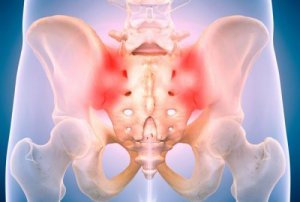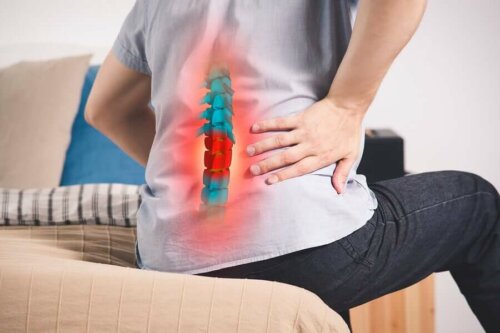Sacroiliac Joint Pain - When Sitting is Unbearable


Written and verified by psychologist Valeria Sabater
There’s a tricky spot in your back located right where your spinal column and pelvis come together. It’s a strong joint that supports the weight of the upper half of the human body. Sacroiliac joint pain can be quite intense and sharp due to inflammation.
It is known as sacroiliitis or sacroiliac joint pain, and you notice it mostly when you sit and get up or when you move around at night in your bed. Additionally, it may gradually worsen until even just sitting can feel almost unbearable.
Notably, some consider it a direct result of the sedentary lifestyle that is so pervasive in today’s culture. However, this isn’t completely true. Sacroiliac joint pain be be due to:
- Arthritis
- Pregnancy
- Traumatic falls
- Infection
Find out how to Relieve Hand Arthritis with these Six Natural Remedies
This kind of pain could be due to a herniated disc

Fever, a shooting pain in your lower back that extends to your glutes and thighs… could it be a herniated disc?
Usually, a person with sacroilitis feels increasing discomfort when they get out of bed in the morning and after a few hours of sitting. Thus, don’t wait for it to get worse and consult a doctor as soon as possible.
You must keep in mind that it isn’t easy to diagnose inflammation in one or both of the sacroiliac joints.
As we said above, it’s common for this pain to be attributed to other problems like a herniated disc or even the common lower back pain.
Types of sacroiliac pain
- The first kind is a simple inflammation of the joints that comprise the sacroiliac
- The other kind has to do with improper positions sustaines over long periods of time
For example, maybe you have an ankle issue stemming from an injury or sprain. And, you’ve been walking improperly for a long time. As a result, your sacroiliac area may wear down. Then, the pain may appear without any inflammation.
Other Related Discomforts
- Fever
- Stiffness in the back
- Low back pain that radiates towards the lower extremities
- Intense discomfort when climbing stairs, sitting, tossing and turning in bed, and taking longer than normal strides
Find out about Six Possible Causes of Recurring Hip Pain
Symptoms of sacroiliac joint pain
Sacroiliac joint pain is more common in women than men. This is because it sometimes results from arthritis, lupus, osteoarthritis, or other conditions.
- First, you may feel the pain in the butt and lower back.
- Then, it radiates down the leg, groin, and even to your feet.
- However, the pain is worse when you go up stairs, when you sit, when you move around in bed, or when you take long steps or lunges.
- Sometimes, you may have a fever.
- Additionally, stiffness in the back is common.
Possible causes
The causes of sacroilitis are quite diverse. Thus, doctors should do a complete checkup of their patients to diagnose the problem.
Some of the possible causes are:
- Lupus
- Psoriasis
- Arthritis or osteoarthritis
- Infections such as osteomyelitis
- Infections in the urinary tract
- Crohn’s disease (due to its inflammatory processes)
- Trauma in this area (A bad back fall is one of the most common causes)
- Pregnancy (the weight of the baby on this area usually results in intense pain in the sacrum)
Treatments for sacroiliac joint pain

Before using any kind of treatment, even homemade or natural, getting a proper medical diagnosis is necessary. They may do X-rays, MRIs, tests, and a physical exam in order to diagnose sacroiliitis.
Here are some of the most common—and general—treatments for pain and inflammation:
- Swimming
- Phisiotherapy
- Gentle exercise and stretching
- Anti-inflammatory drugs, muscle relaxants, or cortisone shots
- Radiofrequency denervation is another option to consider (A specialist will determine if it’s an option. It consists of destroying the nerve tissue that’s causing the joint pain.)
- Electrical nerve stimulation in the affected area is now another commonly used treatment
Are you still in pain? Consult a doctor!
As you can see, pain in the sacrum iliac can be due to many things and this is why it’s important to consult a doctor. This is the only way to obtain a proper diagnosis and begin adequate treatment.
In addition to professional treatment, you must maintain a healthy lifestyle to improve your well-being and say goodbye to discomfort.
All cited sources were thoroughly reviewed by our team to ensure their quality, reliability, currency, and validity. The bibliography of this article was considered reliable and of academic or scientific accuracy.
- Personal de Clínica Mayo. Sacroilitis, síntomas y causas.(2017).
https://www.mayoclinic.org/es-es/diseases-conditions/sacroiliitis/symptoms-causes/syc-20350747
- Personal de Clínica Mayo. Sacroilitis, diagnóstico y tratamiento.(2017).
https://www.mayoclinic.org/es-es/diseases-conditions/sacroiliitis/diagnosis-treatment/drc-20350751
- Revista de la Sociedad Española del Dolor. Vol 21, no. 3, Madrid. Dolor sacroiliaco. (2014)
http://scielo.isciii.es/scielo.php?script=sci_arttext&pid=S1134-80462014000300001
- E. Mejía, M. Arias, K. Valdez, S. Carrillo2, G. Infante. Revista de la Sociedad Española del Dolor. 3: 170-180; 2008 Dolor de la articulación sacroilíaca. Anatomía, Diagnóstico y Tratamiento.
This text is provided for informational purposes only and does not replace consultation with a professional. If in doubt, consult your specialist.








